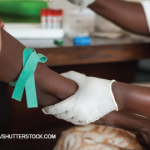
Although HIV testing may seem outside our scope of practice as rheumatologists, it’s important to consider incorporating it into your screening procedures, along with tests for hepatitis B and C.
Image Credit: Africa Studio/SHUTTERSTOCK.COM
It has been nearly 35 years since the original descriptions of what now is recognized as AIDS (the acquired immune deficiency syndrome), an advanced form of infection secondary to the human immunodeficiency virus (HIV). The epidemic of HIV infection remains the singular most dramatic epidemic of our generation and will likely remain with us for generations to come.
The disease itself (i.e., HIV infection) has been transformed from a highly fatal illness with a progressive course and no known therapy to a complex but manageable disease for those with access to antiviral therapy. Socially, the epidemic of HIV infection has changed from one of high visibility attended by fear and stigmatization to one that now has lost much of its exclusivity, affecting all segments of the population to some degree, albeit disproportionally.
Management of HIV infection requires the participation of virtually all specialists to attend to its complications and comorbidities. An important question for the rheumatology community is: What is our current role and responsibility in caring for the nearly 1 million infected patients living today, some of whom will need our services in the years to come?
Our review approaches this question in three parts. The first section reviews the transformation of HIV infection from a devastating immunodeficiency to a chronic inflammatory disease with remarkable symmetry to several connective tissue diseases. The second discusses the dramatic deceleration of HIV-associated autoinflammatory manifestations and the emergence of a new set of rheumatic morbidities. The final section focuses on four areas that we believe rheumatologists and advanced practitioners in rheumatology need to be aware of to be in a position to provide optimal care.
From Immunodeficiency to Chronic Inflammatory Disease
On June 5, 1981, an account appeared in the Morbidity and Mortality Weekly Report describing five men from the Los Angeles area with a previously undescribed immunodeficiency. This marked the recorded beginning of the AIDS epidemic. Many clinicians and researchers suspected that AIDS had an infectious etiology, but it took until 1983 for the discovery of the virus.1
In retrospect, we can now view this epidemic as having three phases, beginning with its presentation as a devastating immunodeficiency in which individuals, often homosexual men or intravenous drug users, developed serious and multiple opportunistic infections. These infections were often treatable, such as pneumocystis pneumonia (caused by p. jirovecii, formerly known as p. carinii), serious mycobacterial and fungal infections, as well as opportunistic malignancies, such as Kaposi’s sarcoma (KS). Such a constellation had not been previously described in otherwise healthy individuals, and this phase, lasting roughly through the end of the first decade of AIDS, could be considered the era of morbidity and mortality due to treatable opportunistic infections.
One striking area of clinical similarity between HIV infection and RA is the aaccelerated cardiovascular disease.
A second recognizable phase of the epidemic evolved when both diagnosis and management had greatly improved to the point at which patients were recognized earlier and afforded antimicrobial prophylaxis for many of these opportunistic infections (e.g., SMZ-TMP to prevent PJP). During this phase, which may be viewed as the era of morbidity and mortality due to untreatable opportunistic complications, patients succumbed to those complications having either no effective therapy, such as progressive KS and progressive multifocal leukoencephalopathy, or profoundly challenging infections to treat, such as disseminated CMV and other pathogens. Without effective antiviral therapy, which at the time was limited to only a few drugs, the prognosis for the infected population was grim, and by 1993, AIDS was the leading cause of death among people age 25–44.1


